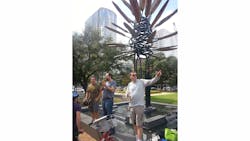Houston is historically known as a car town with its seemingly endless freeway system, but some residents are pushing changes to move people out of their cars and onto their feet.
The Greenway Bayou System is connecting neighborhoods across the city and transforming the community, but it’s still a long ways from where supporters want to see it.
“The reason this happened was some remarkable political grassroots,” said Harris County Metropolitan Transportation Authority Board Member Christof Spieler.
Houston Parks Board Member Michael Skelly said the idea of a greenway along the city’s bayous was first imagined by a local planner in 1910. The idea was to utilize low value land prone to flooding into a greenway.
The idea was kicked around for decades, but it wasn’t until 2011 when the city first started taking strong steps to make the idea a reality.
Skelly began pitching the idea to residents by meeting in Market Square Park and taking residents for bicycle rides along the bayous regardless if there was trail or not. Once riders saw the potential for what could be, it began to generate support.
Skelly said supporters then approached the city to put a bond measure to voters, which then passed with 68 percent support. The measure cleared $100 million in bonding to build the project and the private sector pitched in another $120 million.
“We think we’ve done a pretty good job of capturing an idea and running with it,” Skelly said.
Once construction began on the path, it then started a whole new process of getting it built in a way to make sure residents got the most from the system. However, on a tour Spieler and Skelly helped lead Oct. 12 during the APTA Expo, they mentioned there are still plenty of gaps in connectivity along the lines.
“We as a city have had a lot of land to expand on over the years…so we’re sort of a little too married to the single use of land,” Skelly said. “And when you come up with something like this idea, the trick is to get these different public agencies to come up with dual uses of land, so that requires a lot of coordination that can be unnatural at times.”
The gaps are being filled due to continued community support for the greenway. Spieler said they’ve worked to connect the poor areas of town like the near northside with jobs in the downtown area in order to make sure it’s not a system only for the affluent.
“This trail bypasses infrastructure that would be otherwise really difficult to cross on a bike,” he said.
Development is starting to sprout up in depressed areas of town along the greenway and at the elevated light rail station at Burnett Street a new bus transfer point is planned along with a vision to cater more to bicycle parking than car parking.
It’s also cleaning up the bayous around Houston which have often been used by residents to dispose of trash because they now see the benefit of having healthy waterways.
“It all takes a while, but we’re going to get there,” Skelly said.




